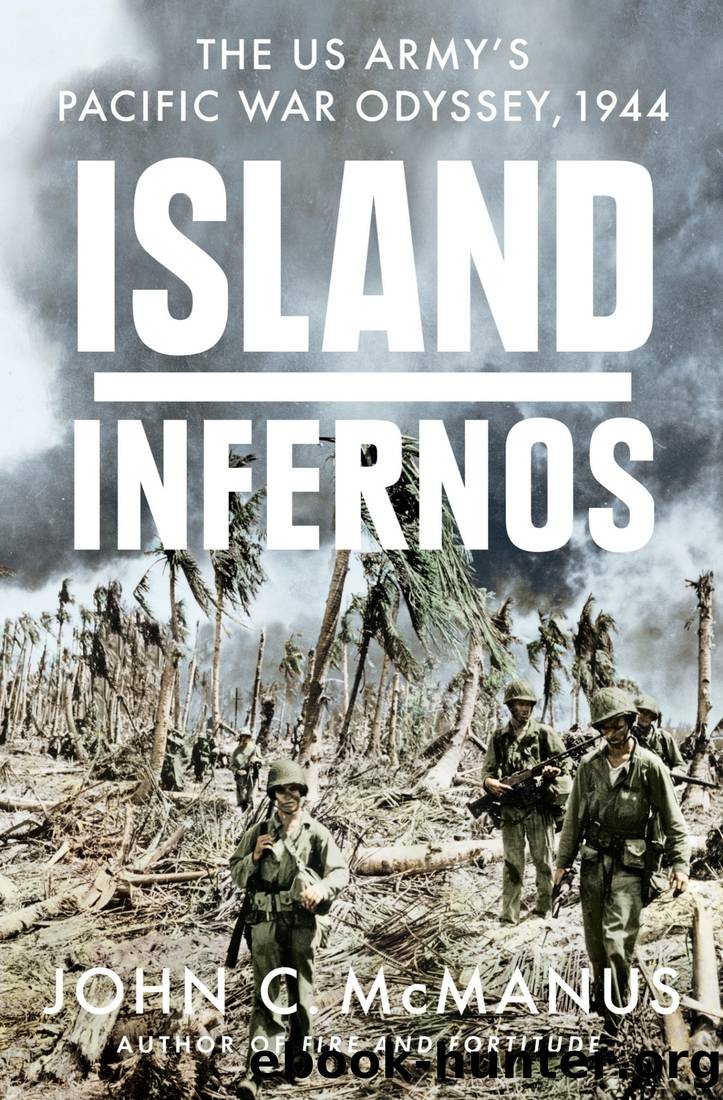Island Infernos by John C. McManus

Author:John C. McManus [McManus, John C.]
Language: eng
Format: epub
Published: 2021-11-09T00:00:00+00:00
* * *
â
On June 15, D-day, the bombardment began at 0530. To Sergeant Yamauchi, staring with bulging eyes at the American ships, the enemy fleet looked like âa large city had appeared offshore. When I saw that, I didnât even have the strength to stand up.â Vice Admiral Turner had carefully divided Saipan and neighboring Tinian into seven firing sectors and organized his bombardment ships to shell targets inside these tightly prepared windows. For an hour and a half, they showered their targets with a variety of ordnance, ranging from the five-inch shells of destroyers to sixteen-inch projectiles from USS Marylandâs main guns, a breathtaking spectacle of firepower. âThere are few things prettier than a naval bombardment, provided one is on the sending not the receiving end and (as in this case) has lost all feeling of compassion for the human victims,â Morison, the naval historian, wrote sagely. âNearby ships belch great clouds of saffron smoke with a mighty roar. Distant ones are inaudible, but their flashes of gunfire leap out like the angry flick of a snakeâs tongue.â Sergeant David Dempsey, a Marine Corps combat correspondent, watched âthe shells bite into the coral sand and shred the palm trees that lined the shore.â Explosions pulverized buildings in Garapan and Charan Kanoa, a sugar mill town located in the heart of the 4th Marine Division landing area. Flames raged all over the island. Mount Topatchau boiled with so many fires as to obscure it with smoke. The ships ceased firing and yielded to air strikes from 0700 to 0800. As Dempsey watched, transfixed, the planes âpeeled off, and plummeted savagely down, dropping their bombs a few hundred feet from the ground. As they began their climb the explosions threw bursts of fire, rubble and a talcum-fine dust into the air. In a few minutes the beach was obscured.â
When the planes finished, the ships resumed their fire against beach targets while hundreds of LVTs, all packed with Marines, headed for the coast. A gray-brown pall of smoke and dust had settled over Saipan like a veil. âThe flames are miles high,â Seaman William Schmidt, a crewman aboard LST 120, later wrote to his parents, with a touch of exaggeration. âItâs a reassuring sight.â On the receiving end, Japanese defenders clustered into trenches, pillboxes, dugouts, bunkers, caves, and holes to weather the firepower storm as best they could. âThere was no way of coping with the explosions,â Private Matsuya of the 9th Tank Regiment noted in his diary. âWe could do nothing but wait for them to stop.â Another soldier described the shelling as âtoo terrible for wordsâ but took solace in the notion that he would âdie in true Samurai style.â In hopes of soothing shattered nerves, one young naval officer took solace in alcohol. âThere is something indescribable about a shot of liquor during a bombardment,â he told his diary with a surreal honesty that might have been funny under less dangerous circumstances. Sergeant Kawaguchiâs medical unit set up an aid station at a Shinto shrine, where they began to care for men who were wounded by the shells.
Download
This site does not store any files on its server. We only index and link to content provided by other sites. Please contact the content providers to delete copyright contents if any and email us, we'll remove relevant links or contents immediately.
Harry Potter and the Goblet Of Fire by J.K. Rowling(3023)
Unfinished: A Memoir by Priyanka Chopra Jonas(2911)
Never by Ken Follett(2869)
The Man Who Died Twice by Richard Osman(2289)
Machine Learning at Scale with H2O by Gregory Keys | David Whiting(2263)
Fairy Tale by Stephen King(2058)
Will by Will Smith(2032)
Rationality by Steven Pinker(1759)
The Storyteller by Dave Grohl(1655)
The Dawn of Everything: A New History of Humanity by David Graeber & David Wengrow(1564)
The Dark Hours by Michael Connelly(1562)
The Stranger in the Lifeboat by Mitch Albom(1527)
Cloud Cuckoo Land by Anthony Doerr(1428)
The Becoming by Nora Roberts(1323)
Friends, Lovers, and the Big Terrible Thing by Matthew Perry(1321)
Crying in H Mart by Michelle Zauner(1312)
Einstein: His Life and Universe by Walter Isaacson(1311)
New Morning Mercies: A Daily Gospel Devotional by Paul David Tripp(1299)
A Short History of War by Jeremy Black(1295)
